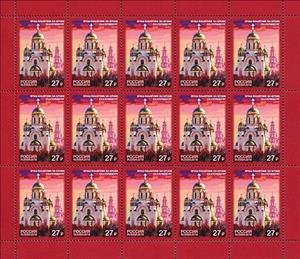Mini Sheet: Church on the Blood, Yekaterinburg (Russia 2018)
Church on the Blood, Yekaterinburg (Russia 2018)
17 July (Russia ) within release Church on the Blood, Yekaterinburg goes into circulation Mini Sheet Church on the Blood, Yekaterinburg face value 15*27 Russian ruble
| Mini Sheet Church on the Blood, Yekaterinburg in catalogues | |
|---|---|
| Colnect codes: | Col: RU 2018-36KB |
Mini Sheet is horizontal format.
Also in the issue Church on the Blood, Yekaterinburg:
- Mini Sheet - Church on the Blood, Yekaterinburg face value 15*27;
- Stamp - Church on the Blood, Yekaterinburg face value 27;
Mini Sheet Church on the Blood, Yekaterinburg it reflects the thematic directions:
A church building, often simply called a church, is a building used for Christian religious activities, particularly worship services. The term in its architectural sense is most often used by Christians to refer to their religious buildings, but it is sometimes used (by analogy) for buildings of other religions. In traditional Christian architecture, the church is often arranged in the shape of a Christian cross. When viewed from plan view the longest part of a cross is represented by the aisle and the junction of the cross is located at the altar area. Towers or domes are often added with the intention of directing the eye of the viewer towards the heavens and inspiring church visitors. Modern church buildings have a variety of architectural styles and layouts; many buildings that were designed for other purposes have now been converted for church use; and, similarly, many original church buildings have been put to other uses. The earliest identified Christian church was a house church founded between 233 and 256. During the 11th through 14th centuries, a wave of building of cathedrals and smaller parish churches occurred across Western Europe. A cathedral is a church, usually Roman Catholic, Anglican, Oriental Orthodox or Eastern Orthodox, housing the seat of a bishop.
World War I or the First World War (28 July 1914 – 11 November 1918), also known as the Great War, was a global conflict between two coalitions: the Allies (or Entente) and the Central Powers. Main areas of conflict included Europe and the Middle East, as well as parts of Africa and the Asia-Pacific. There were important developments in weaponry including tanks, aircraft, artillery, machine guns, and chemical weapons. One of the deadliest conflicts in history, it resulted in an estimated 30 million military casualties, plus another 8 million civilian deaths from war-related causes and genocide. The movement of large numbers of people was a major factor in the deadly Spanish flu pandemic.

